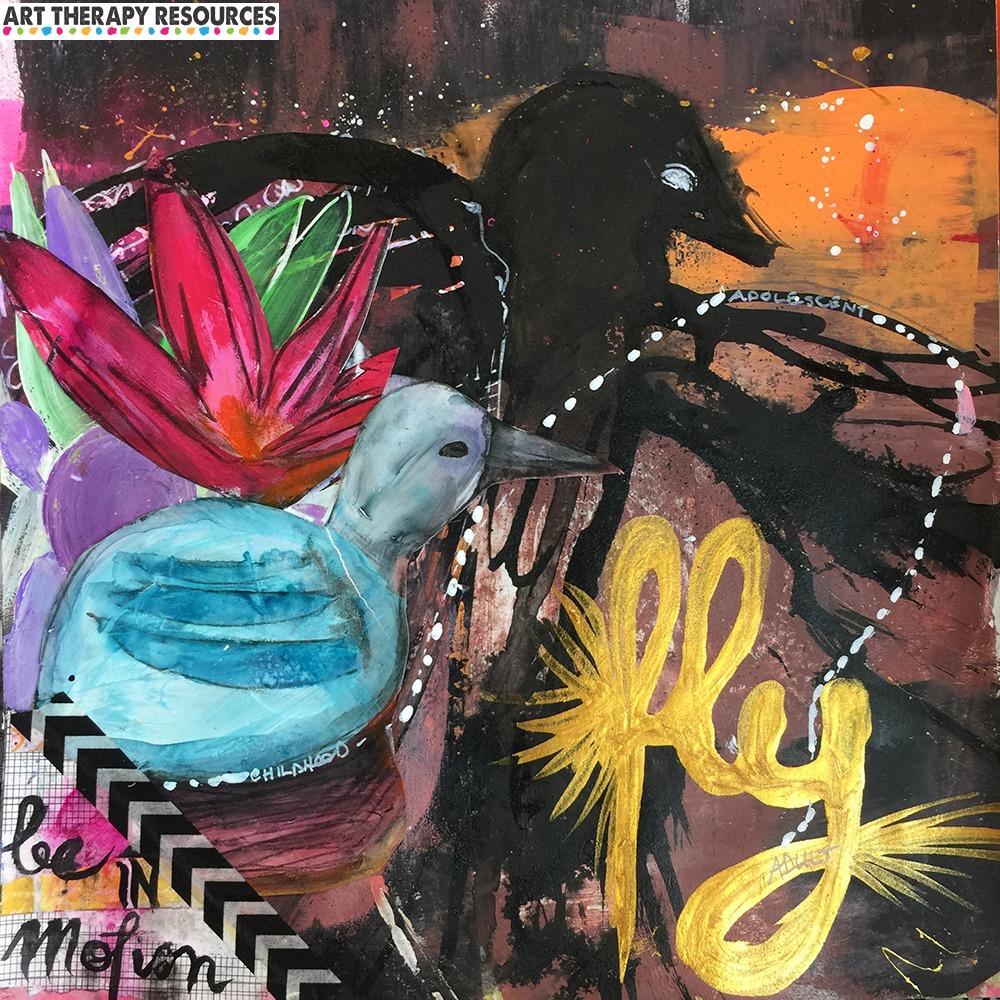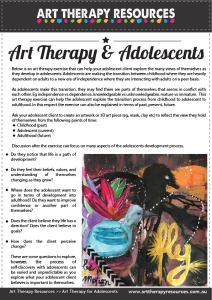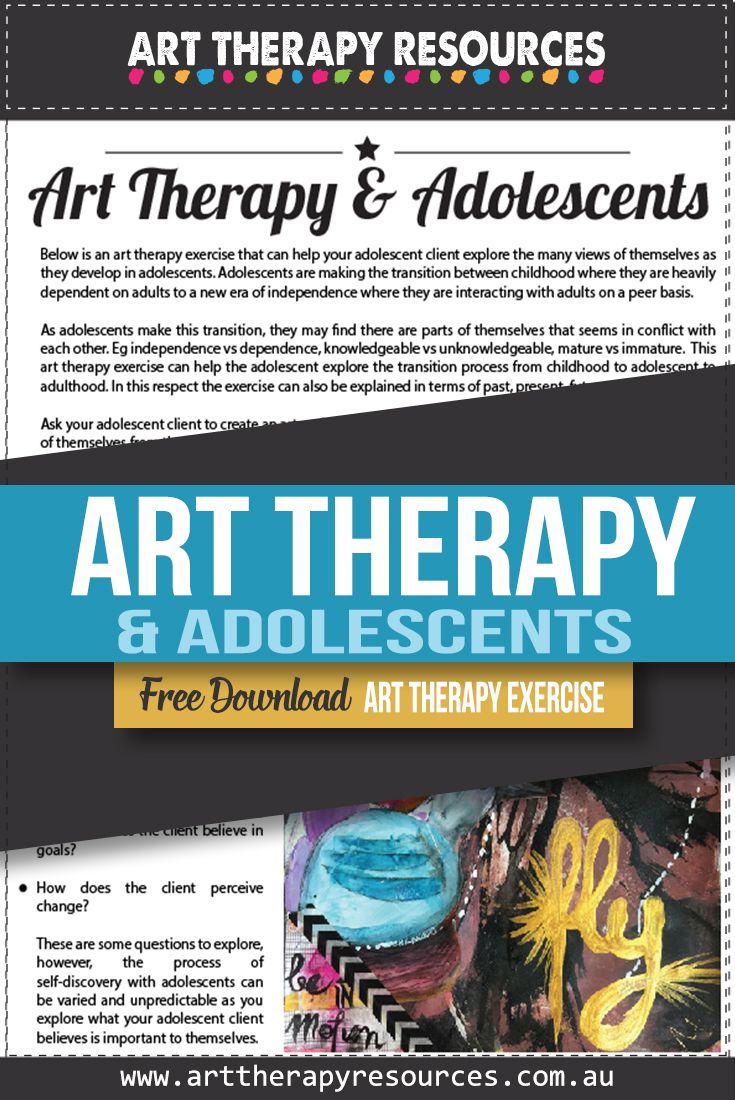THIS POST INCLUDES:
1. Benefits of Art Therapy for Adolescents
2. Adolescent Development
3. Art Therapy Techniques for Adolescents
4. Free Download Art Therapy Exercise
BENEFITS OF ART THERAPY FOR ADOLESCENTS
Many of us have witnessed the freedom of expression that children often display when engaging in art. As adolescents transition from the childhood phase into adulthood, they may still possess some of the expressive nature they held as a child. This can be useful in helping adolescents connect to a point in their past they may have felt less constricted by their social interactions.
In the art therapy space, adolescents can be free to use symbols, imagery, and the malleability of art supplies to explore their emotions and developing thoughts about their identity.
Some of the most common benefits of adolescents engaging in art therapy include:
- Insight into the concept of self
- Coping methods
- Problem solving skills
- Developing new skills through creativity
- Development of abstract thinking through the formal operational stage
- Non-verbal expression of feelings
- Non-judgmental therapeutic process
- More interesting activities then long form talk therapy
- Ability to strengthen bonds with peers through group work
ADOLESCENT DEVELOPMENT
The primary achievement in adolescent development is the formation of identity which forms the basis of the adolescent’s beliefs, values, and social understanding of their role in society.
The development of this identity can be influenced by many factors including both positive and negative influences. The impact of negative influences can cause damage to the adolescent and set them on a pathway in life that has been formed by incorrect beliefs about their value as a person. These negative influences can include intergenerational trauma, family breakdown, abuse from parents/caregivers, educational difficulties at school, and exclusion from peer groups.
Even for adolescents who experience mostly positive influences in their adolescent life, the tension that exists in forming identity can feel like an identity crisis as the adolescent is often forced to assess their position within their family and social peer groups. This can provide a sense of instability while adolescents resist or exacerbate the tension that exists.
Adolescents are heavily influenced by their peers and how they believe they are perceived by peers. This can often mean adolescents are reticent to admit to needing help with an issue that they believe may be perceived by their peers as a weakness.
The stages of development that the adolescent progresses through positions them at a vulnerable stage in terms of developing their belief system about the experiences of mental health and when to seek help.
Adolescents are especially receptive to images, words, and symbols that form a part of their social identity. In this area, art therapy can play an important part in helping adolescents to explore their identity within their social circle.
During the adolescent phase, teens are still developing verbal expression and how they can explain their evolving point of view. The adolescent phase is sometimes a confusing stage where individuals are formalizing their beliefs about themselves, their family, and the way they can resolve conflict in their life. The collision of developing beliefs and the inability to express them can be a frustrating experience for adolescents. Art therapy can help adolescents explore this process and provide them with a visual outlet for their idea when words are not easily expressed.
In the adolescent’s stage, teens are also developing a more complex and evolved understanding of what their emotions are and how they are initiated and subsequently managed. Adolescents begin to understand abstract concepts and how to form judgments as part of their decision-making process.
However, while this is occurring, adolescents are often subject to external pressures from parents, peers, and other authoritative individuals such as teachers, coaches, and bosses in part-time work roles.
As adolescents become more functional in society, their authoritative base moves away from only parents and is impacted by a variety of external influences. This can create a significant amount of pressure on adolescents who are emotionally and psychologically bridging the gap between dependence and independence.
ART THERAPY TECHNIQUES FOR ADOLESCENTS
Art therapy can play a significant part in helping adolescents who are struggling with identity development by helping them explore personal meaning, relationships, their developing personality, and the formation of their identity as they move away from childhood into adulthood.
Art therapy helps adolescents explore the self as well as engage in self-reflection. Furthermore, art therapy helps provide coping techniques that will help an adolescent as they navigate through this growth stage of development.
Some of the major themes in using art therapy with adolescents include:
- Developing identity
- Self-reflection
- Increase self-esteem
- Develop self-knowledge
- Develop coping techniques
- Build positive self-identity
- Existential issues such as the meaning of life
- Exploring roles within society – gender, race, culture, age etc
- Exploring roles with immediate and extended family – creating an expressive family tree
Art therapy is especially useful for adolescents as they have a strong desire to express individuality. This can often mean melding and blending multiple art materials or even various art forms such as video, photography, writing, and drawing.
Younger children may be more prone to create art with simpler known art materials, however, adolescents can often push boundaries of creativity and this can also occur in the therapeutic setting of art therapy.
Techniques that can benefit adolescents in art therapy include:
- Narrative therapy – telling their story
- Journaling – providing a visual and written approach to expressing inner thoughts
- Creating symbols and metaphors linked with the adolescent’s identity
RECOMMENDED READING
Below are some previous blog posts that relate to common adolescent issues your clients may be experiencing:
- Case Study: Using Art Therapy for a Client being Bullied
- Case Study: Using Art Therapy for a Client with Anorexia
- Case Study: Using Art Therapy for a Client with Anxiety (GAD)
- Case Study: Using Art Therapy for a Client with Body Image Issues
- Case Study: Using Art Therapy for a Client with Bulimia
- Case Study: Using Art Therapy for a Client with Depression
- Case Study: Using Art Therapy for a Client with Identity Issues
- Case Study: Using Art Therapy with Clients who Self-harm
- Client Barriers To Art Therapy Participation
- How To Establish a Therapeutic Alliance With Your Client
- Using Art Therapy with Families
ART THERAPY EXERCISE
Below is an art therapy exercise that can help your adolescent client explore the many views of themselves as they develop in adolescents. Adolescents are making the transition between childhood where they are heavily dependent on adults to a new era of independence where they are interacting with adults on a peer basis.
As adolescents make this transition, they may find there are parts of themselves that seems in conflict with each other. Eg independence vs dependence, knowledgeable vs unknowledgeable, mature vs immature.
This art therapy exercise can help the adolescent explore the transition process from childhood to adolescent to adulthood. In this respect, the exercise can also be explained in terms of past, present, future.
Ask your adolescent client to create an artwork or 3D art piece (eg, mask, clay etc) to reflect the view they hold of themselves from the following points of time:
- Childhood (past)
- Adolescent (current)
- Adulthood (future)
Discussion after the exercise can focus on many aspects of the adolescent’s development process.
- Do they notice that life is a path of development?
- Do they feel their beliefs, values, and understanding of themselves changing as they grow?
- Where does the adolescent want to go in terms of development into adulthood? Do they want to improve confidence or another part of themselves?
- Does the client believe their life has a direction? Does the client believe in goals?
- How does the client perceive change?
These are some questions to explore, however, the process of self-discovery with adolescents can be varied and unpredictable as you explore what your adolescent client believes is important to themselves.
Below is an example of this exercise.
- Childhood past is represented by the smaller bird in the nest.
- Adolescent current is represented by the black bird in the background which is the largest picture in the overall artwork.
- Adulthood future is represented by the word FLY to represent future freedom.

FREE DOWNLOAD: Art Therapy Exercise
SIGN UP below to download the FREE Art Therapy Exercise.

BUILD YOUR ART THERAPY REFERENCE MATERIALS:
Pin this image to your Pinterest board.

SHARE KNOWLEDGE & PASS IT ON:
If you’ve enjoyed this post, please share it on Facebook, Twitter, Pinterest. Thank you!
